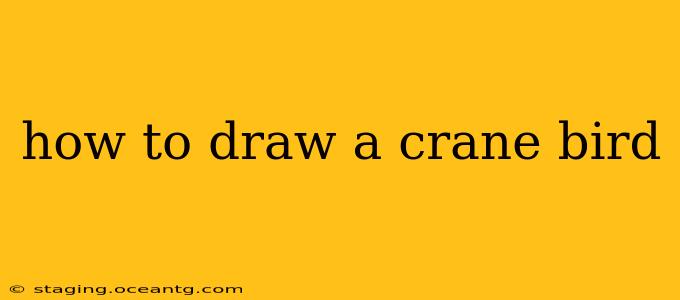How to Draw a Crane Bird: A Step-by-Step Guide for Beginners and Beyond
The graceful crane, with its elegant posture and long neck, is a captivating subject for artists of all skill levels. This guide will walk you through drawing a crane bird, from simple shapes to detailed features, catering to both beginners and those looking to refine their skills.
1. Basic Shapes: Laying the Foundation
Begin by sketching lightly with a pencil. Don't press too hard; these are guidelines that will be refined later.
- Head and Neck: Start with a small circle for the head and a long, slightly curved line extending downwards for the neck. Think of the neck as a gentle "S" curve, not a straight line.
- Body: Attach an oval to the bottom of the neck for the body. The oval should be somewhat elongated, reflecting the crane's streamlined shape.
- Legs: Draw two long, thin lines extending downwards from the body for the legs. These lines should slightly angle outwards.
- Wings (Optional, for a more dynamic pose): If you want to draw the crane with its wings spread, sketch two slightly curved lines extending from either side of the body, forming a broad "V" shape.
2. Refining the Shape: Adding Detail
Now, let's refine the basic shapes to better resemble a crane.
- Head: Add a small, pointed beak to the circle representing the head. Consider adding a subtle curve to the back of the head to create a more natural shape.
- Neck: Smooth the line of the neck, adjusting the curves to give it a more flowing, elegant appearance.
- Body: Refine the oval to a more streamlined shape, subtly tapering towards the tail.
- Legs: Add slight curves to the legs, making them slightly thicker at the top and tapering towards the feet. Draw three short lines at the end of each leg for the toes.
- Wings (if included): Add more detail to the wings by sketching individual feathers. Start with larger, central feathers and add smaller ones around them. Use subtle curves to convey the texture and movement of the feathers.
3. Adding Features: Bringing it to Life
This stage involves adding finer details to bring your crane drawing to life.
- Eyes: Add small, round eyes to the head. The placement will depend on the angle of your crane's head.
- Crest (optional): Some crane species have a crest. If you're drawing one of these, add a small tuft of feathers on top of the head.
- Tail: Add a short, slightly pointed tail at the end of the body.
- Feathers: Add more detail to the body feathers using light shading and short, curved lines to mimic the texture of feathers. You can also use hatching or cross-hatching techniques for areas of shadow.
4. Adding the Finishing Touches: Shading and Refinement
This is where you bring out the three-dimensionality of your drawing.
- Shading: Use light shading to add depth and volume to the bird. Pay attention to the light source and how it affects the shape of the crane. Darker shading will define areas like the underside of the wings and the legs.
- Background (optional): Consider adding a simple background, such as a marsh or a field, to add context to your drawing.
What type of crane am I drawing?
The type of crane you're drawing will influence some of the details. For example, the Red-crowned Crane has a distinctive red cap on its head, while the Sandhill Crane has a different head shape and color. Researching the specific crane species you aim to draw will greatly enhance your accuracy and detail.
How do I draw crane legs?
Crane legs are long and slender, slightly bowed, and end in three toes. Start with simple lines, then refine them to show the slight curvature and tapering towards the feet. Don't forget to add the toes!
What are the key features of a crane bird?
Key features of a crane bird include: a long, elegant neck; long, slender legs; a relatively small head; a pointed beak; and often, a distinctive pattern or color of feathers.
Remember, practice is key. Don't be afraid to experiment with different styles and techniques. The more you draw, the better you will become at capturing the beauty and elegance of the crane bird.
